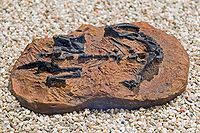- Mussaurus
-
Mussaurus
Temporal range: Late Triassic
Fossil juvenile skeleton Scientific classification Kingdom: Animalia Phylum: Chordata Class: Reptilia Superorder: Dinosauria Order: Saurischia Suborder: Sauropodomorpha Infraorder: Prosauropoda Genus: Mussaurus Binomial name Mussaurus patagonicus
Bonaparte & Vince, 1979Mussaurus (meaning "mouse lizard") was a genus of herbivorous prosauropod dinosaur that lived in southern Argentina during the Late Triassic Period, about 215 million years ago. It gets its name from the small size of the skeletons discovered so far.
However, since Mussaurus is known only from fossilized juvenile and infant skeletons, it is something of a misnomer; adults possibly reached 3 m (10 ft) in length, and weighed 70 kilograms (150 lb).[1] Mussaurus possesses anatomical features suggesting a close, possibly transitional evolutionary relationship with true sauropods.[2] Its evolutionary significance and the light it sheds on prosauropod reproduction make Mussaurus a significant find.
Contents
Discovery
The fossils were first discovered by an expedition led by Jose Bonaparte during the 1970s to the El Tranquilo Formation.[2] There the team found fossilised eggs and hatchlings, which added insight into the reproductive strategies of Mussaurus and other prosauropod dinosaurs.[2] Although the specimens' young biological age gave them proportions that would be highly atypical for an adult prosauropod, that they were indeed prosauropods was easily ascertained by examination of the limbs and pelvic bones.[2]
Reproduction
Mussaurus specimens have been found in association with nests that are believed to contain multiple eggs apiece. The skeleton of Mussaurus infants was small, only six inches long excluding the tail, but a total of 20 to 37 centimetres (7.9 to 15 in) long. This is about the size of a small lizard. Juveniles differed from adults in proportion in addition to size and mass. As is common for dinosaurs, juvenile Mussaurus had tall skulls with short snouts and large eyes.[2]
These proportions are common in many infant vertebrates and are often associated with species that parental care during the vulnerable early stages of life. Adults are expected to have longer snouts and necks, and to look more like one would expect of a prosauropod.
References
- ^ Montague, Jeremy R. (2006). "Estimates of body size and geological time of origin for 612 dinosaur genera (Saurischia, Ornithischia)", Florida Scientist. 69(4): 243-257.
- ^ a b c d e "Mussaurus." In: Dodson, Peter & Britt, Brooks & Carpenter, Kenneth & Forster, Catherine A. & Gillette, David D. & Norell, Mark A. & Olshevsky, George & Parrish, J. Michael & Weishampel, David B. The Age of Dinosaurs. Publications International, LTD. p. 40. ISBN 0-7853-0443-6.
External links
Categories:- Triassic dinosaurs
- Dinosaurs of South America
- Prosauropods
- Sauropodomorph stubs
Wikimedia Foundation. 2010.
